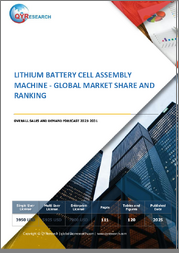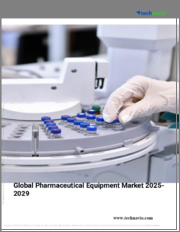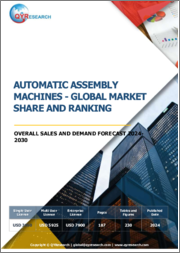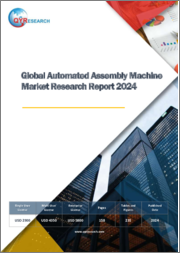
|
시장보고서
상품코드
1572082
세계의 조립 기계 시장 : 부문별 예측(2025-2030년)Assembly Machine Market by Type, End-User Industry, Application, Product Type, Solution Type, Technology, Operation Mode, Size Capacity, Material Type - Global Forecast 2025-2030 |
||||||
조립 기계(Assembly Machine) 시장의 2023년 시장 규모는 29억 8,000만 달러였으며, 2024년에는 32억 3,000만 달러에 달할 것으로 추정 되며, CAGR 8.47%로 성장하며, 2030년에는 52억7,000만 달러에 달할 것으로 예측됩니다.
조립 기계 시장의 범위는 일반적으로 자동차, 전자, 소비재와 같은 제조 분야에서 사용되는 복잡한 부품이나 제품을 조립할 수 있는 기계의 설계, 혁신, 활용을 포함합니다. 조립 기계의 필요성은 생산 공정을 간소화하고 인건비를 절감함으로써 효율성, 정밀도, 속도를 높이고자 하는 제조업계의 요구에서 비롯됩니다. 최종 사용 범위는 대량 생산과 고효율 작업이 필요한 산업, 특히 자동화 및 인더스트리 4.0 기술로 발전하는 분야에서 광범위하게 적용됩니다. 시장 성장은 주로 제품의 복잡성 증가, 자동화로의 전환, 제조 분야의 맞춤화 필요성에 의해 주도되고 있습니다. 주요 영향 요인으로는 기술 발전, 인공 지능과 IoT의 통합, 전 세계적으로 자동화 시스템에 대한 투자 증가 등이 있습니다. 최근의 기회는 친환경 운영과 호환되고, 다양한 제품 장르에 적응하며, 반자동화로 전환하는 중소기업을 위해 확장 가능한 기계를 개발하는 데 있습니다. 그러나 시장은 높은 초기 투자 비용, 새로운 기술을 기존 시스템과 통합하는 데 따른 운영상의 어려움, 첨단 기계를 관리할 숙련된 작업자의 필요성 등으로 인해 어려움에 직면해 있습니다. 또한 공급망 중단으로 인해 필수 구성 요소를 확보하는 데 한계가 있을 수 있습니다. 비즈니스 성장을 위한 혁신 분야로는 완전 자동화된 조립 라인, 예측 유지보수 기술, 사람의 개입을 제한하면서 다양한 작업을 처리할 수 있는 첨단 로봇공학의 개발 등이 있습니다. 생산 공정의 지속 가능성은 증가하는 소비자 및 규제 요구를 반영하여 추가적인 연구 기회를 제공합니다. 시장의 특성은 역동적이고 경쟁이 치열하며 효율성과 기술적 우위를 끊임없이 추구합니다. 성장을 목표로 하는 기업은 현대 제조 생태계의 역동적인 요구에 부응하기 위해 유연하고 비용 효율적인 기계 개발에 집중하는 동시에 시스템 통합 및 친환경 기술 연구에 투자해야 합니다.
| 주요 시장 통계 | |
|---|---|
| 기준연도(2023년) | 29억 8,000만 달러 |
| 추정연도(2024년) | 32억 3,000만 달러 |
| 예측연도(2030년) | 52억 7,000만 달러 |
| CAGR(%) | 8.47% |
시장 역학 : 빠르게 진화하는 조립 기계 시장의 주요 인사이트
조립 기계 시장은 수요 및 공급의 역동적인 상호 작용에 의해 변모하고 있습니다. 이러한 시장 역학의 진화를 이해함으로써 기업은 충분한 정보를 바탕으로 투자결정, 전략적 결정 정밀화, 새로운 비즈니스 기회 획득에 대비할 수 있습니다. 이러한 동향을 종합적으로 파악함으로써 기업은 정치적, 지리적, 기술적, 사회적, 경제적 영역에 걸친 다양한 리스크를 경감할 수 있을 뿐만 아니라, 소비자 행동과 그것이 제조 비용 또는 구매 동향에 미치는 영향을 보다 명확하게 이해할 수 있습니다.
- 시장 성장 촉진요인
- 제조 공정에서 고속 생산과 정밀도에 대한 수요 증가
- 자동 조립 기계를 견인하는 인더스트리 4.0과 스마트 공장 솔루션의 채택 증가
- 지속 가능한 제조 관행과 에너지 효율이 높은 조립 시스템으로의 시프트
- 시장 성장 억제요인
- 고액의 초기 투자와 기술 스킬 부족
- 시장 기회
- 일렉트로닉스 분야에서는 다양한 제품 사양에 대응하기 위해, 커스터마이즈 된 조립 기계에 대한 수요 증가
- 스마트 팩토리 솔루션에 대한 투자가 증가함에 따라 자동차 산업의 고급 조립 기계에 대한 요구가 확대
- 시장 과제
- 기술적 복잡성과 유지보수 문제
Porter's Five Forces : 조립 기계 시장을 탐색하는 전략 도구
Porter's Five Forces 프레임워크는 시장 상황경쟁 구도를 이해하는 중요한 도구입니다. Porter's Five Forces 프레임워크는 기업의 경쟁력을 평가하고 전략적 기회를 탐구하는 명확한 기술을 제공합니다. 이 프레임워크는 기업이 시장 내 세력도를 평가하고 신규 사업의 수익성을 결정하는 데 도움이 됩니다. 이러한 통찰을 통해 기업은 자사의 강점을 활용하고 약점을 해결하고 잠재적인 과제를 피함으로써 보다 탄력적인 시장 포지셔닝을 확보할 수 있습니다.
PESTLE 분석 : 조립 기계 시장의 외부 영향을 파악
외부 거시적 환경 요인은 조립 기계 시장의 성과 역학을 형성하는데 매우 중요한 역할을 합니다. 정치적, 경제적, 사회적, 기술적, 법적, 환경적 요인 분석은 이러한 영향을 탐색하는 데 필요한 정보를 제공합니다. PESTLE 요인을 조사함으로써 기업은 잠재적인 위험과 기회를 더 잘 이해할 수 있습니다. 이 분석을 통해 기업은 규제, 소비자 선호, 경제 동향의 변화를 예측하고 앞으로 예상되는 적극적인 의사 결정을 할 준비를 할 수 있습니다.
시장 점유율 분석 : 조립 기계 시장 경쟁 구도 파악
조립 기계 시장의 상세한 시장 점유율 분석을 통해 공급업체의 성과를 종합적으로 평가할 수 있습니다. 기업은 수익, 고객 기반, 성장률 등 주요 지표를 비교하여 경쟁 포지셔닝을 밝힐 수 있습니다. 이 분석을 통해 시장 집중, 단편화, 통합 동향을 밝혀내고 벤더들은 경쟁이 치열해지는 가운데 자사의 지위를 높이는 전략적 의사 결정을 내리는 데 필요한 지식을 얻을 수 있습니다.
FPNV 포지셔닝 매트릭스 : 조립 기계 시장에서 공급업체의 성과 평가
FPNV 포지셔닝 매트릭스는 조립 기계 시장에서 공급업체를 평가하는 중요한 도구입니다. 이 행렬을 통해 비즈니스 조직은 공급업체의 비즈니스 전략과 제품 만족도를 기준으로 평가하여 목표에 맞는 충분한 정보를 바탕으로 의사 결정을 내릴 수 있습니다. 네 가지 사분면을 통해 공급업체를 명확하고 정확하게 세분화하여 전략 목표에 가장 적합한 파트너 및 솔루션을 파악할 수 있습니다.
전략 분석 및 추천 : 조립 기계 시장에서 성공으로 가는 길 찾기
조립 기계시장의 전략분석은 시장에서 입지 강화를 목표로 하는 기업에 필수적입니다. 주요 자원, 능력 및 성과 지표를 검토함으로써 기업은 성장 기회를 파악하고 개선을 위해 노력할 수 있습니다. 이러한 접근 방식을 통해 경쟁 구도에서 과제를 극복하고 새로운 비즈니스 기회를 활용하여 장기적인 성공을 거둘 수 있는 체제를 구축할 수 있습니다.
이 보고서는 주요 관심 분야를 포괄하는 시장의 종합적인 분석을 제공합니다.
1. 시장 침투 : 현재 시장 환경의 상세한 검토, 주요 기업의 광범위한 데이터, 시장 도달범위 및 전반적인 영향력 평가를 제공합니다.
2. 시장 개척도 : 신흥 시장 성장 기회를 파악하고 기존 분야의 확장 가능성을 평가하며 미래 성장을 위한 전략적 로드맵을 제공합니다.
3. 시장 다양화 : 최근 제품 출시, 미개척 지역, 산업의 주요 진보, 시장을 형성하는 전략적 투자를 분석합니다.
4. 경쟁 평가 및 정보 : 경쟁 구도를 철저히 분석하여 시장 점유율, 사업 전략, 제품 포트폴리오, 인증, 규제 당국 승인, 특허 동향, 주요 기업의 기술 진보 등을 검증합니다.
5. 제품 개발 및 혁신 : 향후 시장 성장을 가속할 것으로 예상되는 최첨단 기술, R&D 활동, 제품 혁신을 강조합니다.
또한 이해관계자가 충분한 정보를 얻고 의사결정을 할 수 있도록 중요한 질문에 대답하고 있습니다.
1. 현재 시장 규모와 향후 성장 예측은?
2. 최고의 투자 기회를 제공하는 제품, 부문 및 지역은?
3. 시장을 형성하는 주요 기술 동향과 규제의 영향은?
4. 주요 벤더의 시장 점유율과 경쟁 포지션은?
5. 벤더 시장 진입·철수 전략의 원동력이 되는 수익원과 전략적 기회는?
목차
제1장 서문
제2장 조사 방법
제3장 주요 요약
제4장 시장 개요
제5장 시장 인사이트
- 시장 역학
- 성장 촉진요인
- 제조 공정에서 고속 생산과 정밀도 수요 증가
- 인더스트리 4.0과 스마트 팩토리 솔루션의 도입 확대
- 지속 가능한 제조 방법과 에너지 효율이 높은 조립 시스템으로의 전환
- 억제요인
- 초기 투자액이 높고, 기술 스킬이 부족
- 기회
- 다양한 제품 사양에 대응하기 위해 전자 기기 분야에서 커스터마이즈된 조립 기계 수요가 증가
- 스마트 팩토리 솔루션에 대한 투자 증가로 자동차 산업에서 첨단 조립 기계의 필요성이 증가
- 과제
- 기술적 복잡성과 유지보수 문제
- 성장 촉진요인
- 시장 세분화 분석
- Porter's Five Forces 분석
- PESTLE 분석
- 정치적
- 경제적
- 사회적
- 기술적
- 법적
- 환경적
제6장 조립 기계 시장 : 유형별
- 전자동 기계
- 수동 기계
- 반자동 기계
제7장 조립 기계 시장 : 최종 사용자 산업별
- 항공우주 및 방위
- 자동차
- 상용차
- 대형 상용차
- 소형 상용차
- 승용차
- 상용차
- 소비재
- 일렉트로닉스
- 가전
- 산업용 전자 기기
- 음식
- 의료기기
제8장 조립 기계 시장 : 용도별
- 조립
- 절단
- 검사
- 자재관리
- 패키지
- 용접
제9장 조립 기계 시장 : 제품 유형별
- 통합 시스템
- 독립형 기계
제10장 조립 기계 시장 : 솔루션 유형별
- 하드웨어
- 서비스
- 소프트웨어
제11장 조립 기계 시장 : 기술별
- 유압 시스템
- 기계 시스템
- 공압 시스템
- 로봇에 의한 자동화
제12장 조립 기계 시장 : 동작 모드별
- 배치 생산
- 연속 생산
제13장 조립 기계 시장 : 사이즈별
- 대형 기계
- 중형 기계
- 소형 기계
제14장 조립 기계 시장 : 소재 유형별
- 복합재료
- 금속
- 플라스틱
제15장 아메리카의 조립 기계 시장
- 아르헨티나
- 브라질
- 캐나다
- 멕시코
- 미국
제16장 아시아 태평양의 조립 기계 시장
- 호주
- 중국
- 인도
- 인도네시아
- 일본
- 말레이시아
- 필리핀
- 싱가포르
- 한국
- 대만
- 태국
- 베트남
제17장 유럽·중동 및 아프리카의 조립 기계 시장
- 덴마크
- 이집트
- 핀란드
- 프랑스
- 독일
- 이스라엘
- 이탈리아
- 네덜란드
- 나이지리아
- 노르웨이
- 폴란드
- 카타르
- 러시아
- 사우디아라비아
- 남아프리카공화국
- 스페인
- 스웨덴
- 스위스
- 터키
- 아랍에미리트(UAE)
- 영국
제18장 경쟁 구도
- 시장 점유율 분석(2023년)
- FPNV 포지셔닝 매트릭스(2023년)
- 경쟁 시나리오 분석
- 전략 분석 및 제안
The Assembly Machine Market was valued at USD 2.98 billion in 2023, expected to reach USD 3.23 billion in 2024, and is projected to grow at a CAGR of 8.47%, to USD 5.27 billion by 2030.
The scope of the assembly machine market encompasses the design, innovation, and utilization of machines capable of assembling complex parts or products, typically used in manufacturing sectors such as automotive, electronics, and consumer goods. The necessity of assembly machines arises from the manufacturing industry's demand for increased efficiency, precision, and speed, as they streamline production processes and reduce labor costs. The end-use scope broadly covers industries that require high-volume and high-efficiency operations, notably in sectors advancing towards automation and Industry 4.0 technologies. Market growth is primarily driven by the increasing complexity of products, the shift towards automation, and the need for customization in manufacturing. Key influencing factors include technological advancements, the integration of artificial intelligence and IoT, and rising investments in automated systems globally. Recent opportunities lie in developing machines compatible with eco-friendly operations, adaptive to various product genres, and scalable for SMEs shifting towards semi-automation. However, the market faces challenges due to high initial investments, operational challenges in integrating new technologies with existing systems, and the need for skilled operators to manage advanced machines. Additionally, supply chain disruptions can pose limitations on obtaining essential components. Innovation areas ripe for business growth include the development of fully automated assembly lines, predictive maintenance technologies, and advanced robotics which can handle variable tasks with limited human intervention. Sustainability in production processes presents additional research opportunities, reflecting a growing consumer and regulatory demand. The nature of the market is dynamic and competitive, driven by the constant pursuit of efficiency and technological superiority. Companies aiming for growth should focus on developing flexible and cost-effective machines while investing in research on system integration and eco-efficient technologies, to cater to the dynamic needs of the modern manufacturing ecosystem.
| KEY MARKET STATISTICS | |
|---|---|
| Base Year [2023] | USD 2.98 billion |
| Estimated Year [2024] | USD 3.23 billion |
| Forecast Year [2030] | USD 5.27 billion |
| CAGR (%) | 8.47% |
Market Dynamics: Unveiling Key Market Insights in the Rapidly Evolving Assembly Machine Market
The Assembly Machine Market is undergoing transformative changes driven by a dynamic interplay of supply and demand factors. Understanding these evolving market dynamics prepares business organizations to make informed investment decisions, refine strategic decisions, and seize new opportunities. By gaining a comprehensive view of these trends, business organizations can mitigate various risks across political, geographic, technical, social, and economic domains while also gaining a clearer understanding of consumer behavior and its impact on manufacturing costs and purchasing trends.
- Market Drivers
- Increasing demand for high-speed production and precision in manufacturing processes
- Rising adoption of Industry 4.0 and smart factory solutions driving automated assembly machinery
- Shift towards sustainable manufacturing practices and energy-efficient assembly systems
- Market Restraints
- High initial investment and technical skill shortage
- Market Opportunities
- Growing demand for customized assembly machines in the electronics sector to meet diverse product specifications
- Rising investments in smart factory solutions driving the need for advanced assembly machineries in automotive industry
- Market Challenges
- Technical complexity and maintenance issues
Porter's Five Forces: A Strategic Tool for Navigating the Assembly Machine Market
Porter's five forces framework is a critical tool for understanding the competitive landscape of the Assembly Machine Market. It offers business organizations with a clear methodology for evaluating their competitive positioning and exploring strategic opportunities. This framework helps businesses assess the power dynamics within the market and determine the profitability of new ventures. With these insights, business organizations can leverage their strengths, address weaknesses, and avoid potential challenges, ensuring a more resilient market positioning.
PESTLE Analysis: Navigating External Influences in the Assembly Machine Market
External macro-environmental factors play a pivotal role in shaping the performance dynamics of the Assembly Machine Market. Political, Economic, Social, Technological, Legal, and Environmental factors analysis provides the necessary information to navigate these influences. By examining PESTLE factors, businesses can better understand potential risks and opportunities. This analysis enables business organizations to anticipate changes in regulations, consumer preferences, and economic trends, ensuring they are prepared to make proactive, forward-thinking decisions.
Market Share Analysis: Understanding the Competitive Landscape in the Assembly Machine Market
A detailed market share analysis in the Assembly Machine Market provides a comprehensive assessment of vendors' performance. Companies can identify their competitive positioning by comparing key metrics, including revenue, customer base, and growth rates. This analysis highlights market concentration, fragmentation, and trends in consolidation, offering vendors the insights required to make strategic decisions that enhance their position in an increasingly competitive landscape.
FPNV Positioning Matrix: Evaluating Vendors' Performance in the Assembly Machine Market
The Forefront, Pathfinder, Niche, Vital (FPNV) Positioning Matrix is a critical tool for evaluating vendors within the Assembly Machine Market. This matrix enables business organizations to make well-informed decisions that align with their goals by assessing vendors based on their business strategy and product satisfaction. The four quadrants provide a clear and precise segmentation of vendors, helping users identify the right partners and solutions that best fit their strategic objectives.
Strategy Analysis & Recommendation: Charting a Path to Success in the Assembly Machine Market
A strategic analysis of the Assembly Machine Market is essential for businesses looking to strengthen their global market presence. By reviewing key resources, capabilities, and performance indicators, business organizations can identify growth opportunities and work toward improvement. This approach helps businesses navigate challenges in the competitive landscape and ensures they are well-positioned to capitalize on newer opportunities and drive long-term success.
Key Company Profiles
The report delves into recent significant developments in the Assembly Machine Market, highlighting leading vendors and their innovative profiles. These include ABB Ltd., Bosch Gmbh., Delta Electronics, Emerson Electric, FANUC, Harman International, Honeywell International Inc., Keyence, KUKA, Mitsubishi Electric, Nachi-Fujikoshi, Omron, Panasonic, Rockwell Automation, Schneider Electric, Siemens, SMC Corporation, Universal Robots, Yamaha Motor, and Yaskawa Electric.
Market Segmentation & Coverage
This research report categorizes the Assembly Machine Market to forecast the revenues and analyze trends in each of the following sub-markets:
- Based on Type, market is studied across Fully Automatic Machines, Manual Machines, and Semi-Automatic Machines.
- Based on End-User Industry, market is studied across Aerospace and Defense, Automotive, Consumer Goods, Electronics, Food and Beverages, and Medical Devices. The Automotive is further studied across Commercial Vehicles and Passenger Vehicles. The Commercial Vehicles is further studied across Heavy Commercial Vehicles and Light Commercial Vehicles. The Electronics is further studied across Consumer Electronics and Industrial Electronics.
- Based on Application, market is studied across Assembly, Cutting, Inspection, Material Handling, Packaging, and Welding.
- Based on Product Type, market is studied across Integrated Systems and Standalone Machines.
- Based on Solution Type, market is studied across Hardware, Services, and Software.
- Based on Technology, market is studied across Hydraulic Systems, Mechanical Systems, Pneumatic Systems, and Robotic Automation.
- Based on Operation Mode, market is studied across Batch Production and Continuous Production.
- Based on Size Capacity, market is studied across Large Scale Machines, Medium Scale Machines, and Small Scale Machines.
- Based on Material Type, market is studied across Composites, Metals, and Plastics.
- Based on Region, market is studied across Americas, Asia-Pacific, and Europe, Middle East & Africa. The Americas is further studied across Argentina, Brazil, Canada, Mexico, and United States. The United States is further studied across California, Florida, Illinois, New York, Ohio, Pennsylvania, and Texas. The Asia-Pacific is further studied across Australia, China, India, Indonesia, Japan, Malaysia, Philippines, Singapore, South Korea, Taiwan, Thailand, and Vietnam. The Europe, Middle East & Africa is further studied across Denmark, Egypt, Finland, France, Germany, Israel, Italy, Netherlands, Nigeria, Norway, Poland, Qatar, Russia, Saudi Arabia, South Africa, Spain, Sweden, Switzerland, Turkey, United Arab Emirates, and United Kingdom.
The report offers a comprehensive analysis of the market, covering key focus areas:
1. Market Penetration: A detailed review of the current market environment, including extensive data from top industry players, evaluating their market reach and overall influence.
2. Market Development: Identifies growth opportunities in emerging markets and assesses expansion potential in established sectors, providing a strategic roadmap for future growth.
3. Market Diversification: Analyzes recent product launches, untapped geographic regions, major industry advancements, and strategic investments reshaping the market.
4. Competitive Assessment & Intelligence: Provides a thorough analysis of the competitive landscape, examining market share, business strategies, product portfolios, certifications, regulatory approvals, patent trends, and technological advancements of key players.
5. Product Development & Innovation: Highlights cutting-edge technologies, R&D activities, and product innovations expected to drive future market growth.
The report also answers critical questions to aid stakeholders in making informed decisions:
1. What is the current market size, and what is the forecasted growth?
2. Which products, segments, and regions offer the best investment opportunities?
3. What are the key technology trends and regulatory influences shaping the market?
4. How do leading vendors rank in terms of market share and competitive positioning?
5. What revenue sources and strategic opportunities drive vendors' market entry or exit strategies?
Table of Contents
1. Preface
- 1.1. Objectives of the Study
- 1.2. Market Segmentation & Coverage
- 1.3. Years Considered for the Study
- 1.4. Currency & Pricing
- 1.5. Language
- 1.6. Stakeholders
2. Research Methodology
- 2.1. Define: Research Objective
- 2.2. Determine: Research Design
- 2.3. Prepare: Research Instrument
- 2.4. Collect: Data Source
- 2.5. Analyze: Data Interpretation
- 2.6. Formulate: Data Verification
- 2.7. Publish: Research Report
- 2.8. Repeat: Report Update
3. Executive Summary
4. Market Overview
5. Market Insights
- 5.1. Market Dynamics
- 5.1.1. Drivers
- 5.1.1.1. Increasing demand for high-speed production and precision in manufacturing processes
- 5.1.1.2. Rising adoption of Industry 4.0 and smart factory solutions driving automated assembly machinery
- 5.1.1.3. Shift towards sustainable manufacturing practices and energy-efficient assembly systems
- 5.1.2. Restraints
- 5.1.2.1. High initial investment and technical skill shortage
- 5.1.3. Opportunities
- 5.1.3.1. Growing demand for customized assembly machines in the electronics sector to meet diverse product specifications
- 5.1.3.2. Rising investments in smart factory solutions driving the need for advanced assembly machineries in automotive industry
- 5.1.4. Challenges
- 5.1.4.1. Technical complexity and maintenance issues
- 5.1.1. Drivers
- 5.2. Market Segmentation Analysis
- 5.3. Porter's Five Forces Analysis
- 5.3.1. Threat of New Entrants
- 5.3.2. Threat of Substitutes
- 5.3.3. Bargaining Power of Customers
- 5.3.4. Bargaining Power of Suppliers
- 5.3.5. Industry Rivalry
- 5.4. PESTLE Analysis
- 5.4.1. Political
- 5.4.2. Economic
- 5.4.3. Social
- 5.4.4. Technological
- 5.4.5. Legal
- 5.4.6. Environmental
6. Assembly Machine Market, by Type
- 6.1. Introduction
- 6.2. Fully Automatic Machines
- 6.3. Manual Machines
- 6.4. Semi-Automatic Machines
7. Assembly Machine Market, by End-User Industry
- 7.1. Introduction
- 7.2. Aerospace and Defense
- 7.3. Automotive
- 7.3.1. Commercial Vehicles
- 7.3.1.1. Heavy Commercial Vehicles
- 7.3.1.2. Light Commercial Vehicles
- 7.3.2. Passenger Vehicles
- 7.3.1. Commercial Vehicles
- 7.4. Consumer Goods
- 7.5. Electronics
- 7.5.1. Consumer Electronics
- 7.5.2. Industrial Electronics
- 7.6. Food and Beverages
- 7.7. Medical Devices
8. Assembly Machine Market, by Application
- 8.1. Introduction
- 8.2. Assembly
- 8.3. Cutting
- 8.4. Inspection
- 8.5. Material Handling
- 8.6. Packaging
- 8.7. Welding
9. Assembly Machine Market, by Product Type
- 9.1. Introduction
- 9.2. Integrated Systems
- 9.3. Standalone Machines
10. Assembly Machine Market, by Solution Type
- 10.1. Introduction
- 10.2. Hardware
- 10.3. Services
- 10.4. Software
11. Assembly Machine Market, by Technology
- 11.1. Introduction
- 11.2. Hydraulic Systems
- 11.3. Mechanical Systems
- 11.4. Pneumatic Systems
- 11.5. Robotic Automation
12. Assembly Machine Market, by Operation Mode
- 12.1. Introduction
- 12.2. Batch Production
- 12.3. Continuous Production
13. Assembly Machine Market, by Size Capacity
- 13.1. Introduction
- 13.2. Large Scale Machines
- 13.3. Medium Scale Machines
- 13.4. Small Scale Machines
14. Assembly Machine Market, by Material Type
- 14.1. Introduction
- 14.2. Composites
- 14.3. Metals
- 14.4. Plastics
15. Americas Assembly Machine Market
- 15.1. Introduction
- 15.2. Argentina
- 15.3. Brazil
- 15.4. Canada
- 15.5. Mexico
- 15.6. United States
16. Asia-Pacific Assembly Machine Market
- 16.1. Introduction
- 16.2. Australia
- 16.3. China
- 16.4. India
- 16.5. Indonesia
- 16.6. Japan
- 16.7. Malaysia
- 16.8. Philippines
- 16.9. Singapore
- 16.10. South Korea
- 16.11. Taiwan
- 16.12. Thailand
- 16.13. Vietnam
17. Europe, Middle East & Africa Assembly Machine Market
- 17.1. Introduction
- 17.2. Denmark
- 17.3. Egypt
- 17.4. Finland
- 17.5. France
- 17.6. Germany
- 17.7. Israel
- 17.8. Italy
- 17.9. Netherlands
- 17.10. Nigeria
- 17.11. Norway
- 17.12. Poland
- 17.13. Qatar
- 17.14. Russia
- 17.15. Saudi Arabia
- 17.16. South Africa
- 17.17. Spain
- 17.18. Sweden
- 17.19. Switzerland
- 17.20. Turkey
- 17.21. United Arab Emirates
- 17.22. United Kingdom
18. Competitive Landscape
- 18.1. Market Share Analysis, 2023
- 18.2. FPNV Positioning Matrix, 2023
- 18.3. Competitive Scenario Analysis
- 18.4. Strategy Analysis & Recommendation
Companies Mentioned
- 1. ABB Ltd.
- 2. Bosch Gmbh.
- 3. Delta Electronics
- 4. Emerson Electric
- 5. FANUC
- 6. Harman International
- 7. Honeywell International Inc.
- 8. Keyence
- 9. KUKA
- 10. Mitsubishi Electric
- 11. Nachi-Fujikoshi
- 12. Omron
- 13. Panasonic
- 14. Rockwell Automation
- 15. Schneider Electric
- 16. Siemens
- 17. SMC Corporation
- 18. Universal Robots
- 19. Yamaha Motor
- 20. Yaskawa Electric















